Manufacture Dates of Swiss Schmidt-Rubin
Rifles
Last updated: 01/27/2001
Swiss Schmidt-Rubin rifles do not have the date of manufacture stamped on
any of the rifle parts, so determining when the rifle (and mismatched
parts, if any) were manufactured must be determined from the serial
numbers. The definitive work on this subject, and Schmidt-Rubin rifles in
general, is Die Repetiergewehre der Schweiz, Die Systeme Vetterli
und Schmidt-Rubin, by Reinhart, Sallaz, and am Rhyn (ISBN
3-7276-7102-5, copyright 1991 by Verlag Stocker-Schmid AG,
Dietikon-Zuerich, Schweiz), from which the tables given here are adapted.
The notes about the various models of Schmidt-Rubin rifles are pilfered
almost verbatim from Rifles of the World, 2nd edition,
by John Walter (ISBN 0-87349-202-1, copyright 1998, published by Krause Publications, 700 E. State
Street, Iola, WI 54990-0001, USA). The rifle photographs are from Samco Global Arms, and are used
with permission.
Below is a short description of the various models of Swiss Schmidt-Rubin
rifles, and then the tables that are necessary to determine when a
particular rifle was manufactured (given the model and serial number).
Contents
Introduction
Eduard Rubin (1846-1920) developed the first successful small-caliber
copper-jacketed bullets that could withstand velocities higher than were
normal in the 1880s. Rubin cartridges with a caliber of 8.1-9.6 mm were
tested against an 8.6 mm Hebler pattern in Switzerland in 1882. The
Hebler cartridge, which had a paper-mache core, attained a prodigious
velocity but the Rubin pattern proved to be far more accurate.
In 1884, Schweizerische Industrie-Gesellschaft converted 130 Vetterli
rifles to fire 7.5 mm and 8 mm Rubin cartridges. Most were adapted from
obsolete infantry weapons, but a few had been trial guns of 1873-75; these
had a distinctive bolt-support guide extending back above the wrist of the
butt.
Also chambered for Rubin ammunition, Rudolf Schmidt's first straight-pull
bolt mechanism of 1885 relied on an actuating rod, set in a channel on the
right side of the breach, to rotate the bolt through a helical channel cut
in the bolt sleeve. Twin lugs were provided midway along the bolt sleeve,
locking into the receiver directly above the trigger.
Back to table of contents
Model 1889

This rifle was officially adopted on June 26, 1889. Tooling had already
begun in the state factory, and so the first deliveries were surprisingly
speedy. The M1889 was a most unusual design, with a characteristically
Swiss nose cap/bayonet lug/stacking rod assembly, and a receiver with a
noticeable gap between the trigger guard and the magazine. The great
length of the bolt weakened the Schmidt system greatly. Production ceased
in 1897 after 211,890 rifles and 40-50 drill rifles (Exerzierwaffen) had
been delivered.
Model 1889 rifles are available from
Samco Global Arms.
Manufactured 1891-1897 at Eidgenoessische Waffenfabrik, Bern.
Total production: about 212,000
Back to table of contents
Model 1889/96
The inherent weaknesses of the 1889-pattern Schmidt action were recognized
after protracted experience with the standard 7.5 mm 1890-pattern
cartridge had been gained. As soon as attempts were made to increase the
muzzle velocity, the problems intensified.
Testing of 50 modified rifles allowed the improved Vogelsang/Rebholz
action to be adopted on September 27, 1897. Though the 1889/96 rifle
resembled its predecessor externally, the locking lugs had been moved to
the front of the bolt-sleeve. This strengthened the action by placing
less of the sleeve under compressive stress, and reduced the gap between
the trigger and the magazine by 0.4 inches.
The rifles were reclassified as the '[Infantrie-]Gewehr 89/96' in 1909; by
November 1912, 127,050 service rifles and about 20 Exerzierwaffen had been
made.
Manufactured 1897-1912 at Eidgenoessische Waffenfabrik, Bern.
Total production: 127,000
Back to table of contents
Model 1897 Cadet Rifle
The Kadettengewehr was adopted on July 27, 1898, after trials with guns
derived from the Mannlicher cavalry carbine and the Schmidt-system rifles.
The single-shot M1897 had a special quadrant sight with differing sets of
gradations for the Ordonnanzpatrone (to 1200 meters on the left side) or
the reduced-charge Kadetten-Patrone (to 400 meters on the right). In
addition to standard guns, about 40 sub-caliber trainers were also made.
Manufactured 1898-1927 at Eidgenoessische Waffenfabrik, Bern.
Total production: 7900
Back to table of contents
Model 1900 Short Rifle
Adopted on April 9, 1901, the Kurzgewehr was based on the 1896-pattern
action; apart from its length, the smaller magazine and reduced-range
sight, it was similar to the M1889/96 infantry rifle.
Many surviving 1900-type guns were among the 26,340 carbines and short
rifles converted to '1911' standards by Eidgenoessische Waffenfabrik in
1913-1920. Accepting 7.5 mm Ordonnanz 11 cartridges, they had four-groove
rifling.
Manufactured 1901-1911 at Eidgenoessische Waffenfabrik, Bern.
Total production: 18,750
Back to table of contents
Model 1905 Cavalry Carbine
Preceded by a handful of experimental designs - including one with a
folding stock and another with a three-piece cleaning rod carried beneath
the forend - the Karabiner 05 was adopted in 1905 to replace the 1893-type
Mannlicher. Stocked virtually to the muzzle, preventing the attachment of
bayonets, it had a full-length handguard and a sling-slot in the butt.
A decree signed on January 13, 1911, ordered the Eidgenoessische
Waffenfabrik to modify 26,340 surviving M1900 short rifles and M1905
carbines to approximate to the 1911 pattern. The work was undertaken in
Bern in 1913-1920. The converted guns had four-groove rifling and
chambered 7.5x55 1911-type cartridges.
Manufactured 1906-1911 at Eidgenoessische Waffenfabrik, Bern.
Total production: 7900
Back to table of contents
Model 1896/11

In 1913, as a result of a decree signed on January 13, 1911, conversion of
1896-type rifles to approximate to the 1911 pattern began in the
Eidgenoessische Waffenfabrik. By March 1, 1920, 135,770 rifles had been
altered. They had four-groove rifling and chambered the Ordonnanz 11
cartridge.
As might be expected, this model markedly resembled the Model 1911 Rifle,
some of the differences being:
- rounded buttplate on the M96/11, flat on the M11;
- pistol grip worked into the stock on the M96/11, integral to the
stock on the M11;
- cutouts on the bottom of the receiver for older magazines on the
M96/11, none on the M11 (picture);
- slightly differently shaped trigger guard on the M96/11 than on the
M11 (picture).
Model 1896/11 rifles are available from Samco Global Arms.
Back to table of contents
Model 1911
A universal increase in muzzle velocity, arising from widespread adoption
of point-bullet ammunition, caused further problems with the Swiss rifles.
Trials were undertaken in 1908-10 with modified bullets and rifles
embodying a strengthened Vogelsang/Rebholz action. Apart from the tangent
sight, these guns resembled their predecessors externally - though, once
dismantled, three large holes were found to be bored through the bolt
sleeve to reduce weight.
The perfected [Infantrie-]Gewehr 11 was formally approved on January 10,
1913, together with adaptations of several earlier weapons. The new guns
had a strengthened action, a hold-open to signify an empty magazine, a
pistol-grip stock and an improved rear sight.
Manufactured 1913-1919 at Eidgenoessische Waffenfabrik, Bern.
Total production: 133,000
Back to table of contents
Model 1911 Carbine

Adopted concurrently with the 1911-pattern infantry rifle in January 1913,
to replace the short rifle and cavalry carbine, this was readily
distinguished by its short barrel and stock. It was mechanically
identical to the rifle.
Model 1911 carbines are available from Samco Global Arms.
Manufactured 1914-1933 at Eidgenoessische Waffenfabrik, Bern.
Total production: 184,200
Back to table of contents
Model 1931 Short Rifle

By 1930, it had become clear that important changes were required in the
1911-type Schmidt action to keep abreast of improved technology. On
January 22, 1932, therefore, the Bundesrat approved the manufacture of
about 20 experimental short rifles; the Karabiner 31 was formally adopted
on June 16, 1933.
Great changes had been made in the action which, though retaining the
essence of the original Schmidt principle, locked into the receiver ring
rather than behind the magazine well. In addition, the bolt did not
project as far beyond the bolt carrier, reducing the length compared with
the 1896-type action by 2.4 inches.
The Karabiner 31 had a longer barrel than the Karabiner 11, which was of
similar overall length. An improved sight was fitted, and the semi-pistol
grip stock - with a sling bar let into the left side of the butt - was
retained by a clamping nose cap accepting any of the standard Swiss sword
bayonets.
Military production finished in 1958 after more than half a million
Karabiner 31 had been made in the Bern factory. A hundred otherwise
standard examples were supplied in the 1930s to equip the elite Swiss
Guard (or 'Papstliche Schweizergarde') in the Vatican; these guns were
apparently numbered 249047-249146.
Several cutaway examples of the Karabiner 31 were also manufactured.
Illustrated are photographs of the top and left side of
the receiver area of one example (photographs courtesy of Thomas Wenk).
Model 1931 short rifles are available from Samco Global Arms.
Manufactured 1933-1958 at Eidgenoessische Waffenfabrik, Bern.
Total production: 582,230
Back to table of contents
Model 1931/42 and 1931/43
Sniper Rifles
Experiments had been undertaken with optically-sighted Karabiner 11 as
early as 1919, but the project had been shelved until trials with
Karabiner 31 and Zeiss, Wild, Gerber and Kern sights began in 1935 in the
Schiessschule Walenstadt.
Though the low-power Kern sight was accepted in November 1940 and a
hundred experimental carbines had been manufactured in 1943, the perfected
Zf.-Kar.31/42 was not approved until July 1, 1944. It had a 1.8x sight,
offset on the left side of the receiver alongside the bolt. Each sight
had a small auxiliary tangent sight and a unique pivoting periscope head.
Otherwise identical to its 31/42 predecessor, the Model 31/43 had an
improved 2.8x sight on the left side of the receiver.
Manufactured 1944-1946 at Eidgenoessische Waffenfabrik, Bern.
Total production: 2240
Back to table of contents
Model 1955 Sniper Rifles
Based on the Model 1931 short rifle and featuring a top-mounted Kern 3.5x
sight (graduated to 800m), this rifle was adopted in 1956 to replace the
M31/42 and M31/43. The 1955-type guns had a special half-stock with a
checkered pistol grip, a folding bipod and a special muzzle brake.
Manufactured 1957-59 at Eidgenoessische Waffenfabrik, Bern.
Total production: 4150
Back to table of contents
Bayonets
There are six basic types of sword bayonets for the Schmidt-Rubin rifles,
all of which have a muzzle ring and a short, flat quillon approximately
1+3/4 incles in length. There is also a rod bayonet, for which see below.
Color photographs courtesy of Ronnie Wilson, and nomenclature from
Bayonets from Janzen's Notebook, with alternates (indicated
by italics) being from Reinhart, Sallaz, and am Rhyn where they
differ from Janzen.
- Model 1889: The fullered blade is 11+5/8 inches in length, and
it has plain wooden grips. It has a tendency to slide out of the
scabbard.
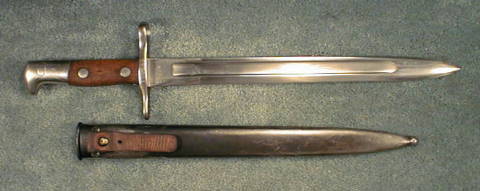
(Closeup of
ricasso)
- Model 1889/99 (1889/1918): Similar to the Model 1889,
except for a stud which was mounted in the fuller's groove to prevent the
bayonet from sliding out of the scabbard.
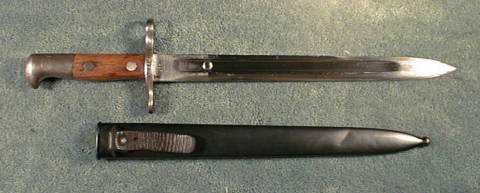
(Closeup of
ricasso)
- Model 1889/11 (1899): Also similar to the Model 1889,
except that a ramp was machined into the fuller's groove to prevent the
bayonet from sliding out of the scabbard.
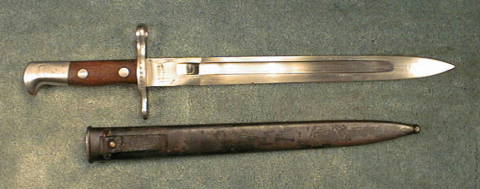
(Closeup of
ricasso)
- Model 1892 (1889/92): An all steel rod bayonet
manufactured using the blade from an old socket bayonet. It was issued to
cyclists and machine gunners.

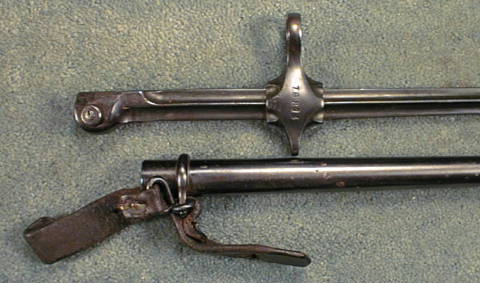
- Model 1906 Pioneer: A transitional sawback bayonet having a
Vetterli blade and a Schmidt-Rubin handle.

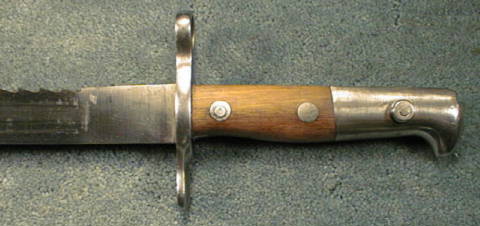
- Model 1914 Pioneer: The long, heavy sawback blade is
approximately 19 inches in length. The blade is fullered on the right
side, and flat on the left.

- Model 1918 - Similar to the Models 1889, 1889/99, and 1889/11
except that the blade is double edged and unfullered.
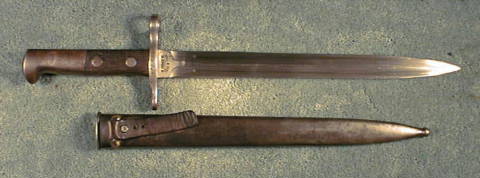
(Closeup of
ricasso)
Back to table of contents
Manufacture Dates
To determine the date of manufacture of a particular rifle, one needs to
know both the model and the serial number. Given the model, go to the
appropriate table and look for the range of serial numbers that spans the
given serial number. The corresponding date for that serial number is
shown in the left column of the table.
For example, given a Model 1911 with a serial number of 2673xx, the tables
show no such serial number for a Model 1911. There is a range spanning
this serial number for a Model 1889/96, however, showing a manufacture
date of 1900. Knowing that the M89/96s were converted to approximate the
M1911 form, we conclude that this rifle is a Model 1889/96/11 manufactured
in 1900.
As another example, given a Model 1931 with a serial number of 9999xx, the
tables indicate that this rifle was manufactured in 1953.
Note: Some rifles will have an uppercase P either after or below
the serial number. Upon retirement from active duty, the retiring Swiss
soldier was given the opportunity to keep his service rifle. Rifles so
obtained were stamped with the uppercase P near the serial number, and
should not be confused with the "Private" series of rifles indicated in
the tables below. The "Private" series of rifles were manufactured to
fill special orders with the factory (such as for export).
Model 1889 - Training Rifles (Instruktionsgewehre)
| Year | Quantity | Serial numbers |
|---|
| 1893 | 40 | E1-E39 (E20 doubled) |
| 1895 | 2 | E43, E45 |
| 1896 | 2 | E42, E44 |
| | |
Model 1889 - Repeating Rifles (Repetiergewehre)
Manufacture ended on April 29, 1897
| Year | Quantity | Serial numbers |
|---|
| 1891 | 24900 | 1-24900 |
| 1892 | 90100 | 24901-115000 |
| 1893 | 59100 | 115001-174100 |
| 1894 | 8787 | 174101-174887
175001-183000
|
| 1895 | 12500 | 183001-195500 |
| 1896 | 12500 | 195501-208000 |
| 1897 | 4000 | 208001-212000 |
| | |
Cavalry Carbine Model 1893 (Kavalleriekarabiner)
| Year | Quantity | Serial numbers |
|---|
| 1896 | 250 | 4251-4500 |
| 1897 | 250 | 4501-4750 |
| 1898 | 250 | 4751-5000 |
| 1899 | 250 | 5001-5250 |
| 1900 | 400 | 5251-5650 |
| 1901 | 500 | 5651-6150 |
| 1902 | 500 | 6151-6650 |
| 1903 | 500 | 6651-7150 |
| 1904 | 300 | 7151-7450 |
| 1905 | 300 | 7451-7750 |
| 1895-1905 | 96 | P1-P96 - Private series,
numbers
P46-P84 for a commercial company, Paris |
| 1897-1903 | 11 | E1-E11, extra series,
entry in
the export book of Waffenfabrik Bern |
| | |
Model 1889/96 - Training Rifles (Instruktionsgewehre)
| Year | Quantity | Serial numbers |
|---|
| 1897 | 2 | E2-E3 |
| 1899 | 4 | E4-E7 |
| 1900 | 4 | E8-E11 |
| 1904 | 4 | E12-E15 |
| 1908 | 4 | E16-E19 |
| | |
Model 1889/96 - Repeating Rifles (Repetiergewehre)
Manufacture ended in November 1912
| Year | Quantity | Serial numbers |
|---|
| 1895 | 50 | 1-50 |
| 1897 | 9000 | 212001-221000 |
| 1898 | 15500 | 221001-236500 |
| 1899 | 15500 | 236501-252000 |
| 1900 | 16500 | 252001-268500 |
| 1901 | 11500 | 268501-280000 |
| 1902 | 12000 | 280001-292000 |
| 1903 | 10000 | 292001-302000 |
| 1904 | 8000 | 302001-310000 |
| 1905 | 6000 | 310001-316000 |
| 1906 | 6000 | 316001-322000 |
| 1907 | 5000 | 322001-327000 |
| 1908 | 5000 | 327001-332000 |
| 1909 | 4800 | 332001-336800 |
| 1910 | 6300 | 336801-343100 |
| 1911 | 1900 | 343101-345000 |
| 1912 | 4000 | 345001-349000 |
| | |
Model 1897 Cadet Rifles (Kadettengewehre)
Sub-caliber
Trainers (per J. Walter) (Einsatzgewehre)
| Year | Quantity | Serial numbers |
|---|
| 1899 | 18 | E1-E18 |
| 1900 | 6 | E19-E24 |
| 1901 | 9 | E25-E33 |
| 1902 | 3 | E34-E36 (P9+P34?) |
| 1903 | 2 | E37-E38 |
| 1904 | 1 | E39 |
| 1907 | 1 | E40 (P40) |
| | |
Model 1897 Cadet Rifles (Kadettengewehre)
| Year | Quantity | Serial numbers |
|---|
| 1898 | 2100 | 1-2100 |
| 1899 | 1649 | 2101-3749 |
| 1900 | 1580 | 3750-5329 |
| 1901 | 499 | 5330-5828 |
| 1902 | 193 | 5829-6021 |
| 1903 | 232 | 6022-6253 |
| 1904 | 151 | 6254-6404 |
| 1905 | 114 | 6405-6518 |
| 1906 | 183 | 6519-6701 |
| 1907 | 150 | 6702-6851 |
| 1908 | 82 | 6852-6933 |
| 1909 | 37 | 6934-6970 |
| 1910 | 236 | 6971-7206 |
| 1911 | 99 | 7207-7305 |
| 1912 | 115 | 7306-7420 |
| 1914 | 231 | 15001-15231 |
| 1915 | 33 | 15232-15264 |
| 1916 | 70 | 15265-15334 |
| 1918 | 2 | 15335-15336 |
| 1924 | 26 | 15337-15362 |
| 1925 | 20 | 15363-15382 |
| 1926 | 80 | 15383-15462 |
| 1927 | 15 | 15463-15477 |
| 1898-1919 | 45 | P1-P45, Private series
entry in
the export book of Waffenfabrik Bern |
| | |
Model 1889/1900 Short Rifles (Kurze Gewehre)
| Year | Quantity | Serial numbers |
|---|
| 1901 | 5000 | 1-5000 |
| 1902 | 885 | 5001-5885 |
| 1903 | 915 | 5886-6800 |
| 1904 | 1000 | 6801-7800 |
| 1905 | 1500 | 7801-9300 |
| 1906 | 1500 | 9301-10800 |
| 1907 | 1750 | 10801-12550 |
| 1908 | 1750 | 12551-14300 |
| 1909 | 1650 | 14301-15950 |
| 1910 | 1500 | 15951-17450 |
| 1911 | 1300 | 17451-18750 |
| ? | 176 | P1-P176 [sic], Private series,
entry in
the export book of Waffenfabrik Bern |
| 1903 Zoll | 89 | P72-P150 |
| 1904 Zoll | 300 | P173-P472 |
| ? | 50 | P501-P550 |
| Zoll | 394 | P551-P944 |
| Zoll | 190 | P951-P1140 |
| Zoll | 103 | P1141-P1243 |
| | |
Note:
Zoll - Customs service
Model 1905 Cavalry Carbines (Kavalleriekarabiner)
| Year | Quantity | Serial numbers |
|---|
| 1906 | 810 | 1-810 |
| 1907 | 2790 | 811-3600 |
| 1908 | 2600 | 3601-6200 |
| 1909 | 500 | 6201-6700 |
| 1910 | 600 | 6701-7300 |
| 1911 | 600 | 7301-7900 |
| 1906-1914 | 39 | P1-P39, Private series,
entry in
the export book of Waffenfabrik Bern |
| | |
Model 1896/11 Infantry Rifles (Infanteriegewehre)
These
rifles carry the serial numbers of the Model 1896 rifles from which they
were modified
| Year | Quantity |
|---|
| 1912 | 5000 |
| 1913 | 40000 |
| 1914 | 51000 |
| 1915 | 38000 |
| 1916 | 1500 |
| 1918 | 200 |
| 1919 | 50 |
| 1920 | 20 |
| |
Model 1911 Infantry Rifles (Infanteriegewehre)
Manufacture
ended on October 1, 1919
| Year | Quantity | Serial numbers |
|---|
| 1912 | 6000 | 355001-361000 |
| 1913 | 14000 |
349001-355000
361001-369000 |
| 1914 | 5000 | 369001-374000 |
| 1915 | 22000 | 374001-396000 |
| 1916 | 32000 | 396001-428000 |
| 1917 | 31000 | 428001-459000 |
| 1918 | 20000 | 459001-479000 |
| 1919 | 3000 | 479001-482000 |
| ? | 200 | P5000-P5200, Private series,
last
manufactured on October 10, 1919,
entry in the export book of
Waffenfabrik Bern |
| ? | 1 | P5219 |
| ? | 698 | P5251-P5948 |
| | |
Model 1911 Carbines (Karabiner)
Manufacture ended on July
11, 1933
| Year | Quantity | Serial numbers |
|---|
| 1914 | 6000 | 30001-36000 |
| 1915 | 4000 | 36001-40000 |
| 1916 | 13000 | 40001-53000 |
| 1917 | 16100 |
53001-54400
55001-62000*
62301-70000** |
| 1918 | 19000 | 70001-89000 |
| 1919 | 2000 | 89001-91000 |
| 1920 | 6500 | 91001-97500 |
| 1921 | 8500 | 97501-106000 |
| 1922 | 7500 | 106001-113500 |
| 1923 | 7900 | 113501-121400 |
| 1924 | 7600 | 121401-129000 |
| 1925 | 7500 | 129001-136500 |
| 1926 | 9900 | 136501-146400 |
| 1927 | 12600 | 146401-159000 |
| 1928 | 11500 | 159001-170500 |
| 1929 | 12800 | 170501-183300 |
| 1930 | 9900 | 183301-193200 |
| 1931 | 8800 | 193201-202000 |
| 1932 | 9200 | 202001-211200 |
| 1933 | 3900 | 211201-215100 |
| 1913-1919 | 300 | P2001-P2300, Private
series
entry in the export book of Waffenfabrik Bern |
| Zoll | 18 | P2013-2030 |
| Zoll | 8 | P2037-P2044 |
| Zoll | 30 | P2071-P2100 |
| Zoll | 100 | P2101-P2200 |
| without entries | 4 | P2201-P2204 |
| ? | 19 | P2205-P2223 |
| Zoll | 50 | P2251-P2300 |
| | |
Notes:
Zoll - Customs service
* Serial numbers 54401-55000 and 62001-62300 are missing (900 pieces)
** Serial numbers 69701-69750 have double entries, but are only entered
once in this list. Consequently, the total of the Model 1911 Carbines
listed here comes to 185150 pieces.
Special Model 1911 Rifles (Extra-Gewehre)
| Year | Who | Serial
numbers |
|---|
| 1915 | Kriegstechnische Abteilung, Bern - |
E500 |
| 1914 | Koenigliche Gewehrpruefungskommission,
Ruheleben-Spandau -
Spanische Gesandtschaft, Bern - |
E501
E502 |
| 1919 | Emile Galley, Lausanne - | E503 |
| 1920 | Hollaendische Gesandtschaft, Bern -
Englische Gesandtschaft, Bern - |
E504
E505 |
| 1915 | Eidgenpessiosches Militaerdepartement, Bern - |
E506-E507 |
| 1917 | Sektion fuer Munition, Thun - |
E508 |
| 1918 | Amerikanische Gesandtschaft, Bern - |
E509 |
| 1919 | Franzoesische Gesandtschaft, Bern - |
E510 |
| 1920 | Franzoesische Kriegsministerium, Paris -
Tiro Suizo, Buenos Aires - |
E511-E520
E521-E522 |
| 1921 | Italienische Gesandtschaft, Bern -
Italienischer Militaerattache, Bern -
Flugplatzdirektion, Duebendorf -
Sektion fuer Schiessversuche, Thun - |
E523
E524
E525
E526-E527 |
| 1922 | Eidgenoessische Munitionsfabrik, Thun -
Eidgenoessische Munitionsfabrik, Thun -
Internationales Wettschiessen, Mailand -
The High Commissioner for the Commonwealth of
Australia, London - |
E525?
E528-E529
E530
E531
|
| 1923 | Franzoesisches Kriegsministerium, Paris - |
E532 |
| 1924 | Eidgenoessisches Schuetzenfest, Aarau -
KTA, fuer Schweden -
KTA, fuer Tschechoslowakei - |
E533-E534
E535
E536 |
| 1925 | KTA, fuer Waffenfabrik Oviedo -
KTA, Bern -
Schiessschule Walenstadt - |
E537
E538-E539
E540-E541 |
| 1926 | Afghanische Regierung (mit Dolch 18) -
KTA, fuer Tschechoslowakei - |
E542
E543 |
| 1934 | J. Alder W+F, Bern - | E544 |
| | |
Notes:
KTA - Kriegstechnischen Abteilung des schweizerischen
Militaerdepartements
W+F - Waffenfabrik
Special Model 1911 Carbines (Extra-Karabiner)
| Year | Who | Serial
numbers |
|---|
| 1918 | Amerikanische Gesandtschaft, Bern |
E1 |
| 1919 | Amerikanische Gesandtschaft, Bern |
E2 |
| 1920 | Hollaendische Gesandtschaft, Bern -
Tiro Suizo, Buenos Aires -
Tiro Suizo, Buenos Aires - |
E3
E5
E6
|
| 1921 | Direktion Eidgenoessische Waffenfabrik, Bern |
E7 |
| 1923 | Franzoesisches Kriegsministerium, Paris |
E4 |
| 1926 | Afghanische Regierung | E8 |
| 1932 | Wojskorny Zaklad, Warschau -
Werkzeugmaschinenfabrik, Oerlikon - |
E9
E10 |
| 1952 | unreadable | E11 |
| | |
Model 1911 Carbines (Karabiner)
Converted from Model
1889/1900 Short Rifles and Model 1905 Cavalry Carbines
| Year | Quantity | Serial numbers |
|---|
| 1913 | 1000 | 1-1000 |
| 1914 | 8000 | 1001-9000 |
| 1915 | 8000 | 9001-17000 |
| 1916 | 8200 | 17001-25200 |
| 1917 | 900 | 25201-26100 |
| 1918 | 100 | 26101-26200 |
| 1919 | 70 | 26201-26270 |
| 1920 | 65 | 26271-26335 |
| | |
Model 1911 Trials Carbines (Versuchs-Karabiner)
| Year | Quantity | Serial numbers |
|---|
| 1923 | KTA, Bern | V1-V10 |
| 1926 | KTA, fuer Schiessschule Walenstadt |
V1-V200 |
| | |
Note: KTA - Kriegstechnischen Abteilung des schweizerischen
Militaerdepartements
Model 1931 Carbines (Karabiner)
| Year | Quantity | Serial numbers |
|---|
| 1933 | 1193 | 520010-521202 |
| 1934 | 15534 | 521203-536736 |
| 1935 | 13664 | 536737-550400 |
| 1936 | 11326 | 550401-561727 |
| 1937 | 11639 | 561728-573366 |
| 1938 | 10344 | 573367-583700 |
| 1939 | 15300 | 583701-599000 |
| 1940 | 33575 | 599001-632575 |
| 1941 | 54150 | 632576-686725 |
| 1942 | 49350 | 686726-736075 |
| 1943 | 50475 | 736076-786550 |
| 1944 | 51900 | 786551-838450 |
| 1945 | 26200 | 838451-864650 |
| 1946 | 15600 | 864651-880250 |
| 1947 | 20950 | 880251-901200 |
| 1948 | 20100 | 901201-921300 |
| 1949 | 15500 | 921301-936800 |
| 1950 | 13200 | 936801-950000 |
| 1951 | 23050 | 950001-973050 |
| 1952 | 21400 | 973051-994450 |
| 1953 | 5549
7450
|
994451-999999
215001-222450 |
| 1954 | 17150 | 222451-239600 |
| 1955 | 11250 | 239601-250850 |
| 1956 | 6400 | 250851-257250 |
| 1957 | 2950 | 257251-260200 |
| 1958 | 3130 | 260201-263330 |
| | |
Model 1931 Carbines - Private series
| Year | Quantity | Serial numbers |
|---|
| 1934 | 16 | ? |
| 1935 | 500 | 400001-400500 |
| 1936 | 100 Zoll | 401001-401100 |
| 1937 | 150 Zoll
200
|
401101-401250
400501-400700 |
| 1938 | 150 | 400701-400850 |
| 1939 | 20 | 401501-401520 |
| 1940 | 150
530
50
50
|
400851-401000
401521-402050
402151-402220
402251-402300 |
| 1941 | 300 | 402301-402600 |
| 1942 | 650 | 402501[sic]-403150[sic] |
| 1943 | 350 | 403151-403500 |
| 1944 | 400 | 403501-403900 |
| 1945 | 600 | 403901-404500 |
| 1946 | 837 | 404501-405337 |
| 1947 | 929
30
|
405322[sic]-406250
E519767-E519796 |
| 1948 | 400 | 406251-406650 |
| 1949 | 650 | 406651-407300 |
| 1950 | 400
50 | 407301-407700
408001-408050 |
| 1951 | 300
50 | 407701-408000
408051-408100 |
| 1952 | 300 | 408101-408400 |
| 1953 | 450
50 | 408401-408850
409051-409100 |
| 1954 | 200
100 |
408851-409050
409101-409200 |
| 1955 | 450
100
|
409201-409650
410151-410250 |
| 1956 | 450 | 409651-410100 |
| 1957 | 50
300 |
410101-410150
410251-410550 |
| 1958 | 475 | 410551-411025 |
| 1959 | 425 | 411026-411450 |
| 1960 | 300 | 411451-411750 |
| 1961 | 300 | 411751-412050 |
| 1962 | 400 | 412051-412450 |
| 1963 | 50
400 |
267331-267380
412451-412850 |
| 1968-1969 | 150 | various numbers |
| 1971 | 150
50 |
269431-269580
269881-269930 |
| Stand (?) 1972 | 250 | various numbers |
| | |
Note:
Zoll - Customs service
Model 1931 serial number allocation, valid after November 1,
1952
| Serial numbers | Allocation
|
|---|
| 215001-350000 | K31 Carbine series, ordered by KTA for
KMV |
| 350001-400000 | K31 Carbine series |
| P400001-P450000 | Private K31 Carbine series |
| 450001-500000 | K31 Carbines with telescopic sights (sniper
versions) |
| 500001-500200 | Trials versions |
| E519701-E519900 | Various special K31s |
| 519901-519999 | Cutaway K31s (running backwards?), last
number 519970 |
| 520001-520150 | Carbine series ordered by KTA, delivered by
W+F for special purposes |
| 520081-520100 | Ditto, reserved for W+F |
| 520151-999999 | Carbine series, ordered by KTA for KMV
|
| after 550651 | Hardened magazine boxes |
| after 540001 | Hardened receivers |
| |
Notes:
KTA - Kriegstechnischen Abteilung des schweizerischen
Militaerdepartements
KMV - Kriegsmaterialverwaltung
W+F - Waffenfabrik
Models 1931/42 and 1931/43 Sniper Rifles
(Zielfernrohr-Karabiner)
| Year | Quantity | Serial numbers |
|---|
| 1943 | 96 | ? |
| 1944 | 403 | ? |
| 1945 | 1537 | ? |
| 1946 | 205 | ? |
| | |
Model 1955 Sniper Rifles (Zielfernrohr-Karabiner)
| Year | Quantity | Serial numbers |
|---|
| 1957 | 170 | 1001-1170 |
| 1958 | 3030 | 1171-4200 |
| 1959 | 800 | 4201-5000 |
| ? | 150 | 5001-5150 |
| | |
Back to table of contents
Back to Old Military Markings home page











